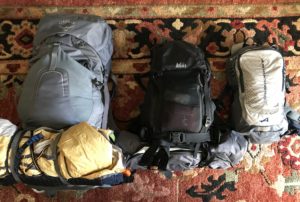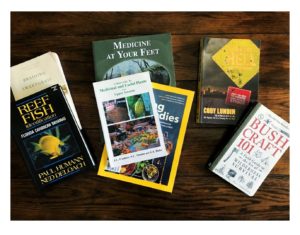Go-Bag or Go Home!

With the more ever present potential of shelter-in-place orders, civil unrest, and flat out disaster I found it apropos to share what I know about packing a “go-bag”…
I’m not trying to paint myself as a survival expert here – too much responsibility – but, what’s a “survival expert” if not someone who has gone into the wild and almost died a few times…?
Sort of like the old saying, “Good judgment comes from experience, and a lot of that comes from bad judgment.”
It is precisely because I’ve found myself in a survival scenario a time or two that I keep a bag – or, a few – on hand in order to be better prepared for the eventual time that I need it.

Plan for the worst and hope for the best, as it were…
As a rule, I try to not to own too much ‘stuff’, but being a bit of a hoarder can be counter-intuitively helpful when kitting out a go-bag…pack your extra stuff, not your everyday stuff. For some reason I own four beanies and tend to wear only the one…no worries – extra beanies are better packed in a go-bag than in a drawer.
I keep 3 go-bags on hand, and 2 everyday-go’s within arm’s reach…each designed and equipped with different scenarios in mind.
My “pro-go” is designed for true, short-term emergencies, while my “winter-go” bag is equipped for a harrowing, several day odyssey…even my “everyday-go” bags have a few survival items in them – fire starters, blades, snacks, plastic bags, etc.
I’m going to break down the “pro-go” because it is likely the most universally applicable – it’s the one that Colorado Department of Transportation is referencing in their recent highway signs that display the cryptic message, “Pack an emergency bag – be prepared”.
This bag is perhaps the least obvious, so if you’re trying to avoid the “prepper” label, this may be the one for you…it also conveniently doubles as a grab and go hiking bag for virtually any day-long scenario.
This bag is one of my smallest in terms of overall volume, and it is purposefully light on supplies and relies, instead, on a pro-level of survival skill. If you can source and purify water reliably, build water-shedding shelter with just a knife; and, hunt, trap, and/or fish then it may make more sense for you to go a little lighter too.
As with anything, don’t do like me…do like you. Cody Lundeen is a hell of a survivalist and he can bug out with two snickers bars and a pen knife – I try that shit and I’d end up Naked And Afraid…

My “pro-go” bag packing list:
- 3 Liters H2O – arguably the most important resource
- Rescue Blanket
- Long Sleeve shirt
- Beanie Hat
- 1 Dehydrated Meal
- 2 days Dog Food
- Advils and an “Energy” Pill
- Metal Cup – can also be used for boiling water
- Paracord
- Leatherman
- Sunscreen
- Toothbrush/Paste
- 2 Lighters
- Locking Gate Carabiner
- 3 Hair-ties
- 1 Alcohol Hand-Wipe
- Fixed Blade Knife – I always carry a folding pocket knife, but fixed blades are better for batoning
- Packing List and Pen – also dynamic items
- Multiple Plastic Bags – can double as water containers
Don’t forget dog food if you have one and want it to come along, or some kid’s stuff if you have those – they need entertainment and snacks even in the best of scenarios. Some personalized comfort items are also great – a piece of gum, or roll of Life Savers can provide a true boost in the face of true horror.
Check the contents periodically for freshness and sanctity, verifying the items against the packing list; and, leave a little room in the top and sides of the pack…some room for possibility – e.g. last minute items like fresh food, guns/ammo, money, masks, hand-sanitizer etc.
—

My choices have been informed by personal experience and exhaustive research…
Here’s a list of resources that you might start with if you’re just diving into this particular topic:
- “When All Hell Breaks Loose” by Cody Lundeen is a good primer for contemporary disaster
- “Bush Craft 101” by Dave Canterbury is handy if you weren’t a Boy Scout
- Tristan Gooley has a wonderful series of books on natural navigation and interpretation
- A guide book to – or, knowledge of – your local flora and fauna is an absolute necessity
- Watch Dual Survival and scour YouTube – there’s some great stuff there
I should also mention that my pranayama practice has served me as well as or better than any item in the most harrowing survival scenarios…I was once caught in a freak, white-out blizzard in the bottom of a canyon – of course I was barefoot and in shorts – strong breathing, and a cool, collected consciousness was the only thing that got me to safety, warmth, and shelter on higher ground where I watched a flash-flood roll off the canyon walls and fill the bottom with rushing water.
Don’t forget that your car is a great big “go bag” (mine has two additional “go bins” in it, along with sleeping materials, blades, extra clothes, and 5 gallons of water always). Keep your bike in good repair too – never know when the roads will be impassable, glutted with traffic, or subject to closure or worse.
Pack a bag or two – you’re not a “crazy-weirdo-prepper”, you’re just “someone who’s ready to go camping for 3 days at a moment’s notice”.
No tool is substitute for a skill – useful in my hands doesn’t mean a damn if it’s not useful in yours…do some research, make a plan, practice it and hope you never need it. Stay sharp – it may mean the difference between whether or not your “go bag” helps you go home…
Good luck, Yogis!
JK
Thanks for reading! If you enjoyed it please consider throwing a few bucks in our virtual tip jar HERE.
Justin “Jud” Kaliszewski is the best-selling yoga teacher and renowned creator of Outlaw Yoga. Author. Artist. Adventurer. Though his studio is currently closed per state order, you can still take his class NOW at outlawyogaclub.com and www.youtube.com/outlawyoga. Find his writing and art at www.justinkaliszewski.com and his presence all over the internet – for an outlaw, he’s shockingly easy to get ahold of.



